Labyrinth How to Play Quick Links: | Objective | Setup | Playing the Game | Moving the Maze | Moving Your Playing Piece | Winning the Game | Variant Games | FAQ | Components |
Objective of Labyrinth
The objective of Labyrinth is to collect all of the treasures, objects and creatures assigned to you; and escape before the other players.
Setup for Labyrinth
- Place the gameboard in the middle of the table.
- Shuffle the maze cards. Randomly select cards and place them in the game board. One maze card will be kept outside of the game board because it won’t fit inside the grid.
- Shuffle the treasure cards. Deal out all of the cards to the players. Each player should receive the same number of cards. Place the pile of cards in a face down pile in front of you. You may look at the top card from your pile but you can’t look at the other cards. You should then put the card back on top of the pile.
- Choose a playing piece. Place it on the game board in the corner corresponding to its color.
- Choose who you want to start the game. Play will proceed clockwise throughout the game.
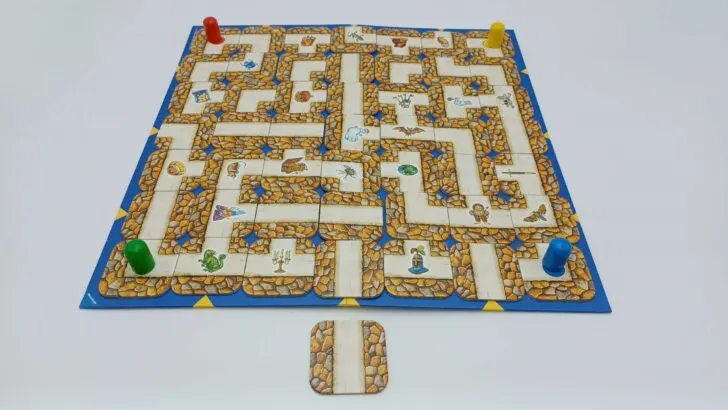
Playing Labyrinth
To begin your turn you can look at the top card on your pile of treasure cards. You can look at this card at any time, but shouldn’t show the card to the other players. The object, treasure, or creature shown on the card is the target location for your turn.
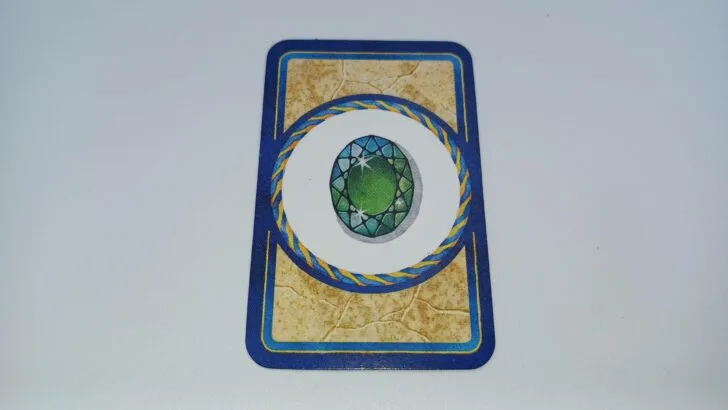
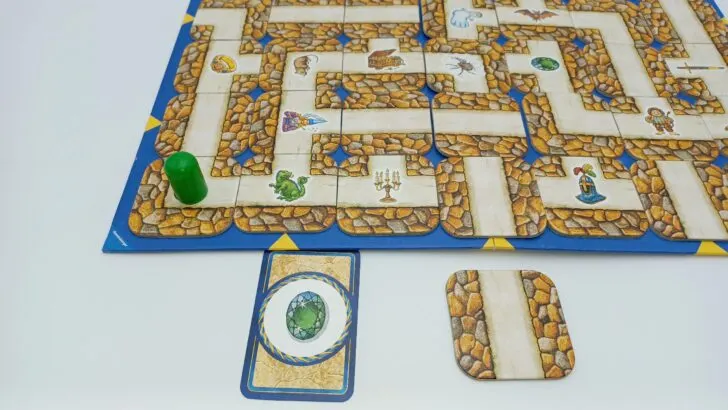
On your turn you will get to take two actions:
- Move the Maze
- Move Your Playing Piece
After you have taken both of these actions, play passes to the next player in a clockwise direction.
Moving the Maze
To start this action you will pick up the maze card that is not currently on the board. For this action you will add this card to one of the edges of the board. You may add the card to any spot on the edge of the board that has an arrow printed on it. When you insert the card you will push on it to slide all of the cards already in that row/column. You will keep pushing on the card until the card on the other side of the row/column is pushed off the board. This card will remain where it is pushed off to let the other players know where you inserted your card.
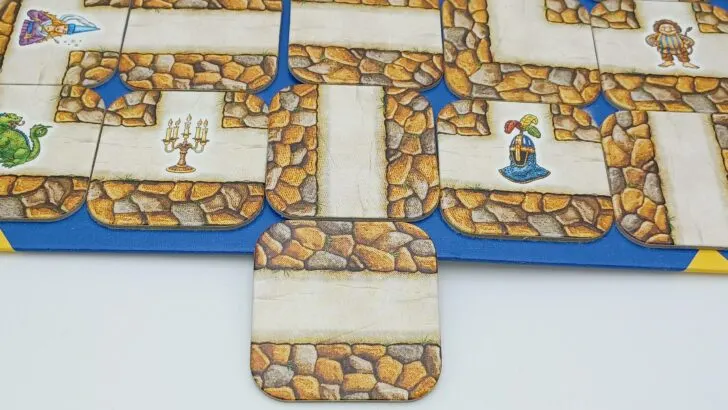
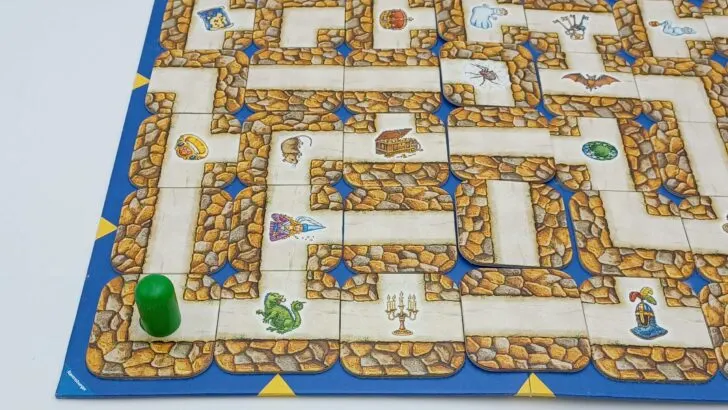
This action is mandatory. You must insert the card into the labyrinth. You may not insert the card that was just pushed out by the previous player so it is moved back into its previous position. Basically you can’t reverse the action that the previous player did.
Pushed Out of the Labyrinth
Should a playing piece be pushed out of the labyrinth due to inserting the new card, the playing piece is added to the card that was just inserted into the maze. This applies whether it is your own piece, or one of the other players’ pieces. Moving a piece to the other side of the board does not count as a movement.
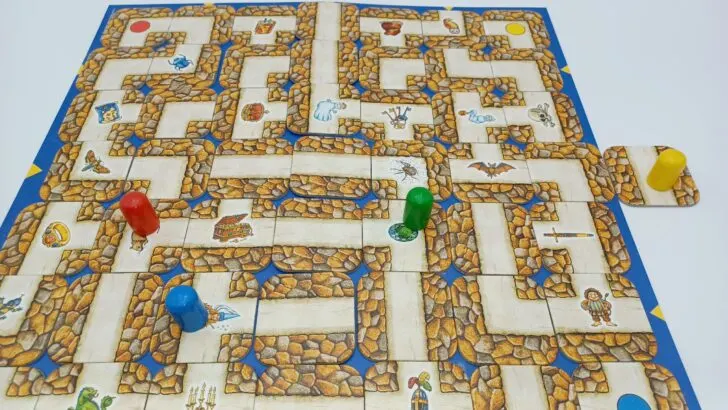
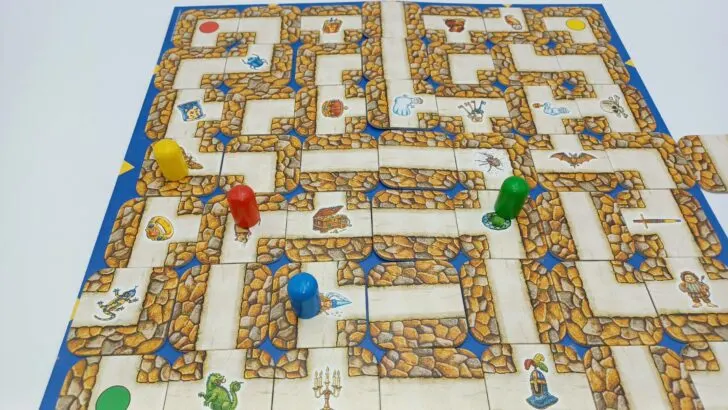
Moving Your Playing Piece
After you insert a card into the labyrinth and shift the cards, you will have the opportunity to move your own playing piece. You can move your playing piece any number of spaces following a corridor that your piece is currently in. You can also choose not to move your piece at all. While moving you can enter or stop on a space that already has another playing piece on it.
When moving your playing piece you are trying to find a way to move to the space that pictures the object, treasure, or creature from the top treasure card on your pile. If you move your playing piece to the corresponding space, you will turn over the card to show that you finished that goal. You can then look at the new top card on your pile to find your next target.
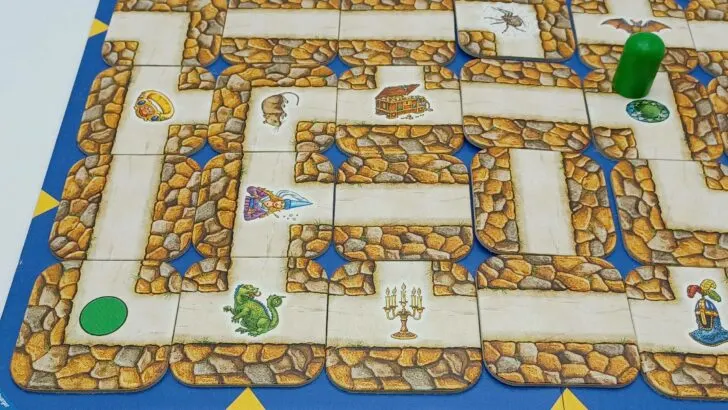
Winning Labyrinth
Once you have flipped over all of your treasure cards, you are close to winning the game. At this point you want to try and move your playing piece back to its starting location.
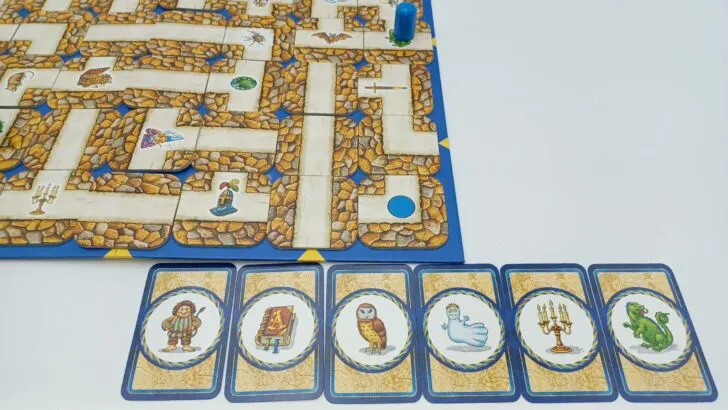
The first player to reach their starting location after completing all of their treasure cards wins the game.
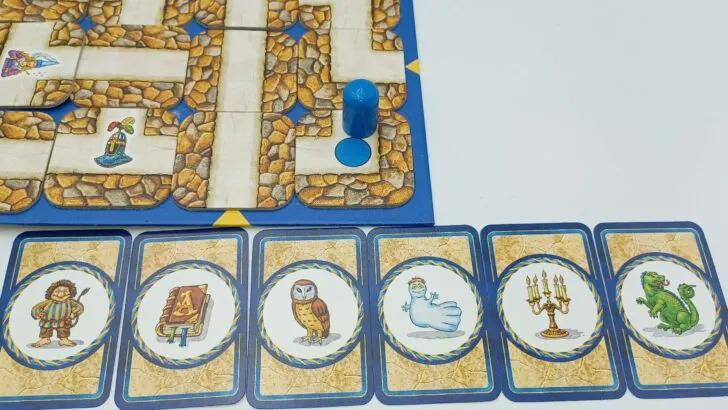
Variant Games
There are two variant games for Labyrinth which can make the game easier/faster.
Younger players may choose to look at all of their treasure cards at any time. Instead of having to reach all of the locations in order, they can move to whichever one is closest to their current position.
To make the game shorter, you can decide to end the game when a player completes all of their treasure cards instead of forcing the player to get back to their start location. If you choose to use these rules, the first player to flip over all of their treasure cards wins the game.
Labyrinth FAQ
If you have any questions about how to play Labyrinth, leave a comment below on this post. I will try to answer any questions asked as best and as quickly as possible.
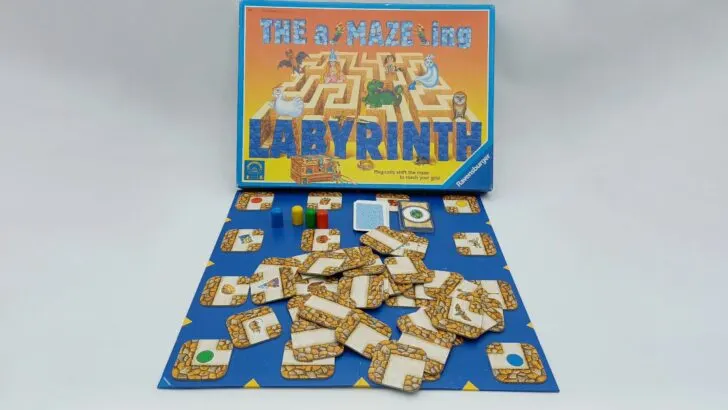
Labyrinth Components
- Gameboard
- 34 Maze Cards
- 24 Treasure Cards
- 4 Wooden Playing Pieces
- Instructions
If you would like to check out our thoughts on the game, check out our Labyrinth review.
Year: 1986 | Publisher: Ravensburger | Designer: Max J. Kobbert
Genres: Family, Tile Placement
Ages: 8+ | Number of Players: 2-4 | Length of Game: 20 minutes
Difficulty: Light | Strategy: Light-Moderate | Luck: Moderate
Where to Purchase: Amazon, eBay Any purchases made through these links (including other products) help keep Geeky Hobbies running. Thank you for your support.
For more board and card game how to plays/rules and reviews, check out our complete alphabetical list of board game posts.

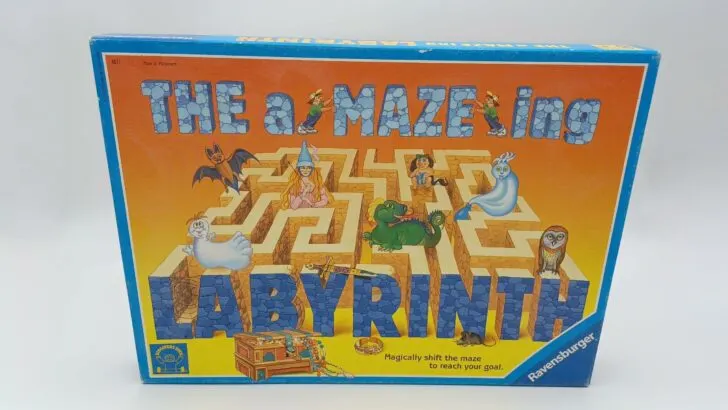
Jm
Friday 21st of June 2019
What happens when you can’t move in any direction???
Eric Mortensen
Saturday 22nd of June 2019
I don't know if the official rules ever specifically addressed this situation. Due to the fact that you can choose not to move your piece at all on your turn, I would assume that you just don't get to move on your turn.
Christine Wenning
Friday 18th of January 2019
We were given this game, so it seemed like something was not right. I found your site in my search. You state that there are 34 maze cards in the game. Then why does your example set-up show 49 +1?? I have 34 maze cards and I do not have all the items that the treasure cards show. is that intentional?
Eric Mortensen
Friday 18th of January 2019
I have not played Labyrinth in quite some time so this is based on what I remember from the game. I am pretty sure that some of the tiles are attached/glued directly to the board (which weren't counted in the total in the contents section) and can't be removed. I think the designers did this to limit which rows and columns you could slide. If I remember correctly I think every other row and column has a tile attached to the edges of the board to prevent you from moving that row or column. There were also a couple tiles attached to the middle of the board. If I remember correctly I think some of these tiles had some of the treasure items on them so that could explain why some of the items in your copy are missing. Does your copy of the game have any tiles directly attached to the gameboard?
Joe Blogg
Monday 19th of November 2018
RULES state https://www.ravensburger.org/uk/discover/labyrinth/index.html
"The treasure cards need to be distributed equally amongst the players, but these must be kept secret. " Therefore if you play as intended, the "cons" section is mostly irrelevant.
As for children...if you want to be humiliated get a couple of 7/8/9 year olds on it. They want to look at your card so they can "help" as they have genuinely become sorry for you, as when 30 seconds are up they just assume you have forgotten it is your turn, not that you are thinking!
Eric Mortensen
Monday 19th of November 2018
I either must have missed that statement in the rules or it could have been something that was changed in later versions of the game (as my copy of the game is one of the older versions of the game). Either way I totally agree with the rule you stated as it would improve the game.
Steven Kearney
Wednesday 23rd of August 2017
How about creating a rule that, once a player finds all 3 treasures, they are now able to replace the tile that another player removes on their turn. That way, the other players may focus more on their game, instead of defense. Maybe the only exception is if the player's piece is on the tile that was removed. The only problem that I see is the player on their way to the base can use that ability to prevent the others from proceeding...
Eric Mortensen
Friday 25th of August 2017
That sounds like an interesting house rule. I might have to try it the next time I play Labyrinth.
Eric